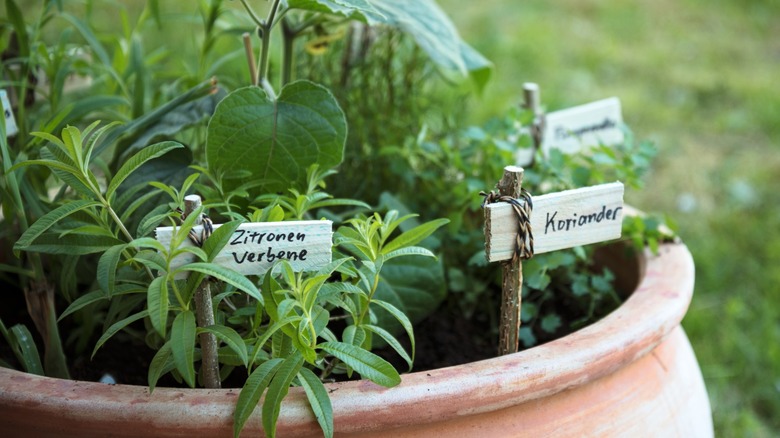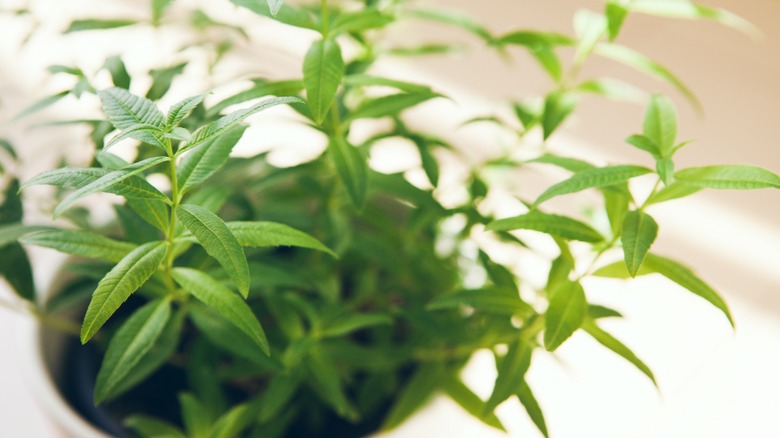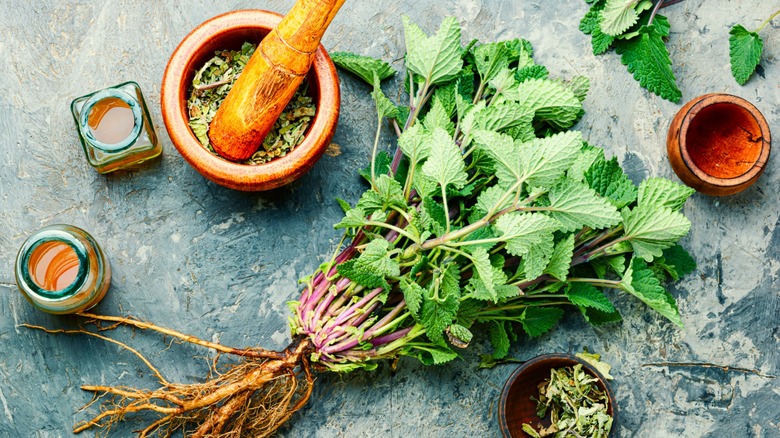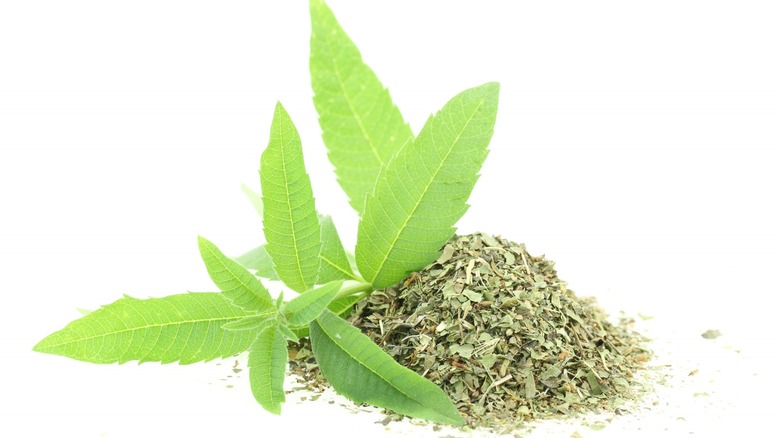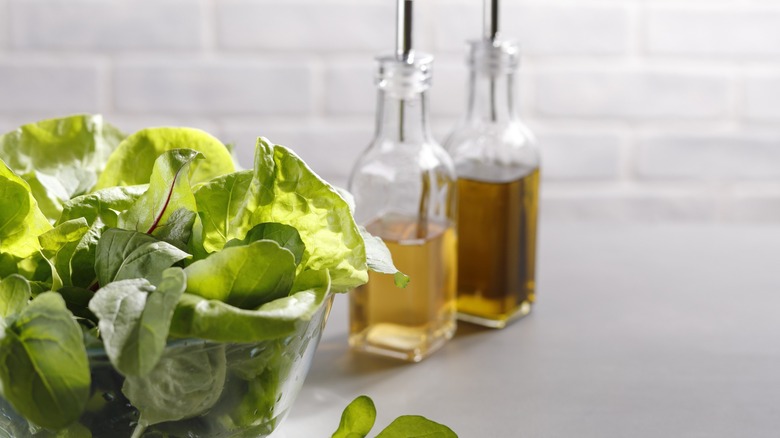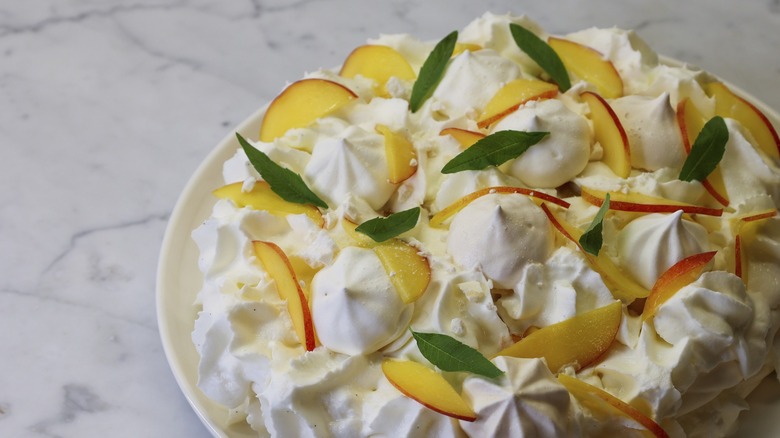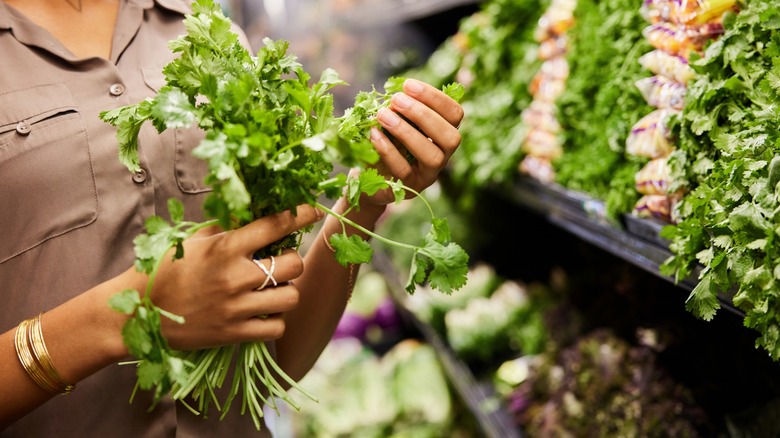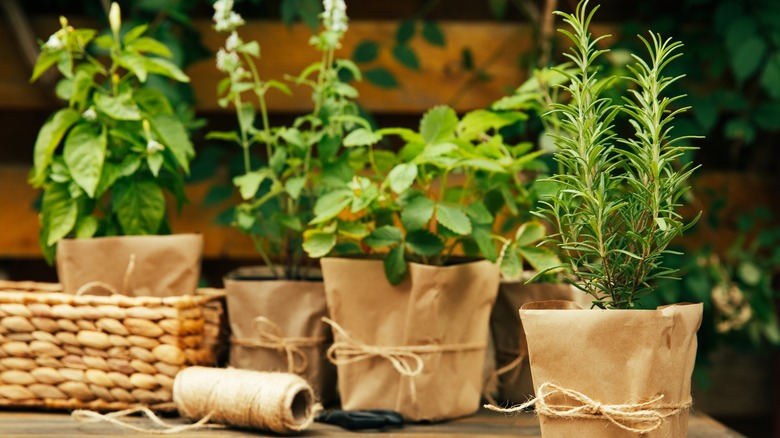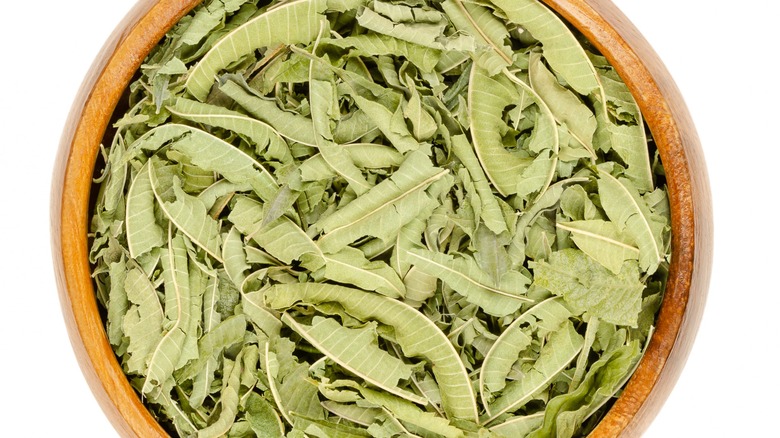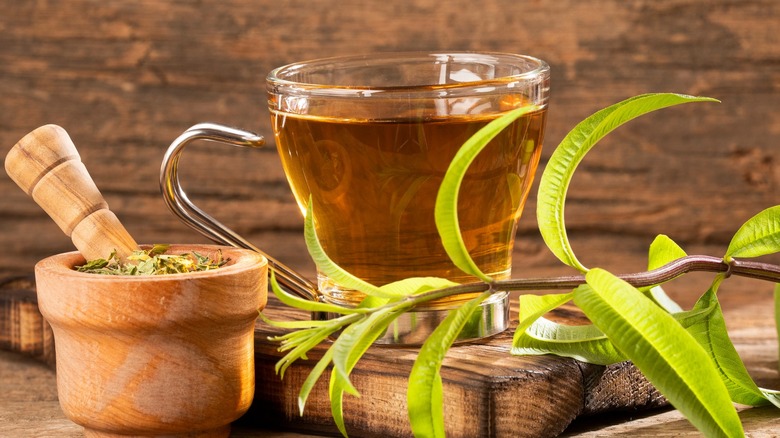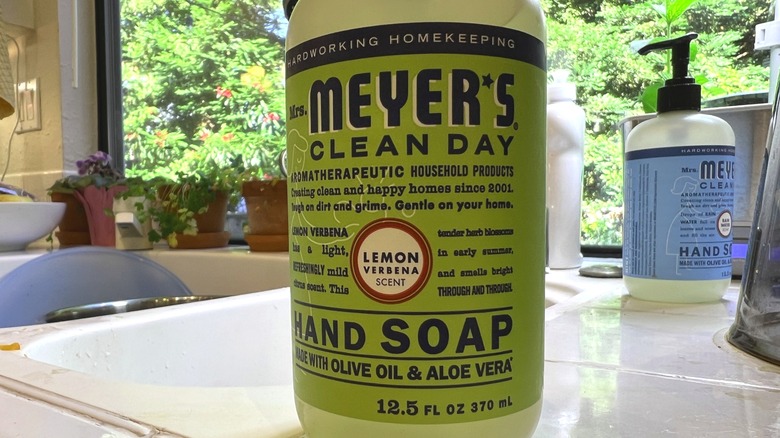What Is Lemon Verbena And What Does It Taste Like?
Lemon verbena might not be all that common to you, as far as cooking herbs go. Depending on where you live, it might not even cross your path. Verbena still isn't commonplace in foods, while it has been used in many fragrances and home products. The fresh citrus scent is a perfect complement to many foodstuffs, however, so you may start seeing it appearing more often, especially come spring and summer. You may recognize it under one of its other names, though – lemon beebrush , or even as Luisa (after the wife of King Carlos IV of Spain, Queen Maria Louisa) if you happen to be in Spain, Portugal, or Greece.
Lemon verbena (Aloysia citriodora or Aloysia triphylla) is part of a large family of plants that do well in gardens, from small border plants with delicate flowers to large, sturdy hedge-appropriate ones. The culinary one can grow 4 to 6 feet with proper light and pruning and will release a bit of scent every time someone brushes against it, making it a delightful addition to your home herb garden. Verbena is a subtle herb and works well in all sorts of dishes, from salad dressings to ice cream and its mildness makes it exceptionally easy to use. The woody stems make it a fairly sturdy plant, while the long pointed leaves and tiny flowers add visual interest. Approach with caution if you live with animals though, as lemon verbena is toxic to dogs, cats, and horses.
What is lemon verbena?
If you're not familiar with lemon verbena, don't fear. While it's been around for quite some time, you'd be forgiven for not noticing it in your grocer's herb selection. Native to Argentina and Chile, verbena does well in gardens that receive a lot of sun. With Spanish exploration booming in the 1600s, the lemony-scented greenery was introduced to Europe, where it was widely used in gardens and scented products. Finally, in the 18th and 19th centuries, it was brought back across the ocean by European migrants, landing in North America.
While the plant is generally better suited to warmer climates with long, sunny days, lemon verbena has still found favor everywhere it's landed, mostly because of the fresh, light scent. It can now be found worldwide, having made its way to Australia, Africa, and parts of Asia. You may not have noticed it in grocery stores or farmer's markets — maybe you weren't even looking for it — but keep an eye out, just in case. Recognizable with long pointed leaves that have a bit of a leathery texture and an unmistakable scent when bruised or crushed, it's gaining traction in many markets here. The fragrance is citrusy, floral, and spicy all at once, and this is one herb that can be used in both sweet and savory dishes, something we love.
How does it compare to other lemon-scented herbs?
There are loads of other citrus-scented herbs out there so why go with one that might be harder to find? Lemongrass is slowly becoming easier to find even in small towns without Asian markets, and lemon thyme is pretty ubiquitous. While lemon pepper is a mixture rather than an actual herb, it will still do in a pinch. Now that home cooks are well and truly branching out and trying whatever we can get our hands on, verbena is starting to see more interest. The lovely thing about verbena is that while it has an abundance of herbaceous lemon scent, what it lacks is just as important — that acidic bite. Without all the citric acid and the bitter pith to contend with, verbena just adds a lilting citrusy floral touch to your dish.
Keep in mind that the scent is what makes verbena so special. It doesn't have a flavor powerful enough to overwhelm your dish but it does have a stronger scent than lemon balm, lemon thyme, lemongrass, or lemon mint, all of which can be considered pretty zippy herbs. Another part of the appeal of lemon verbena is that, if you decide to get into growing it at home (more on that later), verbena isn't wildly invasive like its citrusy cohorts balm or mint and its woody stems make it a gorgeous grower for edging and borders.
Fresh lemon verbena compared to dried
Like most herbs, you'll likely be able to find verbena in both fresh and dried versions. But which is better and for what uses? First, let's talk about fresh herbs — they're not always the most practical purchase for a couple of reasons. They can be more expensive, and you only get a small amount, compared to dried ones. But the flavor is truly outstanding. We'd wager most people would agree that fresh herbs add something that dried just doesn't. If you can get your paws on a fresh bunch, you're also going to need a plan for how to use them.
If it's all you can find, you're on a budget, or you don't know when you'll get to use those dried herbs, then scoring peak freshness might not matter as much. You'll get more green for the money and you'll have more time to decide how to use it if you go with dried. There are still a few things you should keep in mind before substituting dried herbs for fresh ones, such as the potency of each. While fresh herbs will have a brighter taste, dried will have a lot more flavor in a smaller measure. Remember that, generally speaking, 1 tablFespoon of fresh is equal to about 1 teaspoon of dried. Finally, dried herbs can also be added earlier in the cooking process, as fresh herbs will break down much more quickly and can become quite bitter as they cook.
Savory uses for lemon verbena
Verbena can be used in both sweet and savory applications, much like its scent-adjacent relative, the lemon. But that's not all, foodies. This little charmer is pretty delish chiffonaded into a summer salad of fruit, veggies, or a combination of both, or even infused into vinegar to make a punchy little dressing. Or how about in another dressing, the kind served with a bird? Chicken, garlic, and lemon are such a terrific trifecta that we think this trio will get thumbs up all around your table.
While it might not pair well with beef, it works quite nicely with fish and pork too, so you have lots of protein options. We've seen it used to cook a gorgeous fillet of whitefish, cooked en papilotte, or added to a brine for chicken and pork. And don't forget about your veggies — add a small handful to your steamer the next time you want to perk up green beans, broccoli, or sugar snap peas. If you've only ever tried pesto made with basil, maybe you should up the ante and give lemon verbena a try the next time you're making the best pesto ever. Experiment with additional herbs like parsley or play around with different nuts until you find a combo that you like.
It works really well in sweets, too
Sweet applications, like our lemon verbena and raspberry meringue pie, seem like a perfect way to make use of summer's bounty while smothering yourself in meringue, right? Simmering a few leaves with the fruit mixture you're making into jam will add an unexpected pop of flavor. If you're looking for a quicker way to infuse verbena into your dessert, that simple syrup we've already suggested can be added to whipped cream or sorbet for a delicate citrus hint that will elevate whatever you top with it.
One of the most popular applications is to simply add leaves (fresh or dried) to some hot water and enjoy it as a light tisane that works especially well as an after-dinner digestif, even during the balmy summer months. Take your steeping a step further and whip up a simple syrup that will add a splash of je ne sais quoi to your next gin and tonic or French 75. If you're craving a mocktail or just something cool, that simple syrup can also upgrade your iced tea, baby. You have two options here; either brew the fresh leaves with the tea or add the flavored simple syrup after, whatever floats your tasty boat. Try it with Ceylon tea for a stunningly brisk combo.
Where to find lemon verbena
Again, because it's not all quite mainstream yet, you might have to search verbena out but we promise it's worth it. Greengrocers with a fairly extensive collection of fresh herbs might carry it, or specialty spice shops carrying a wide variety of dried ones might be worth a look. We acquiesce that, yes, in some places it might seem like an impossible task but it's out there, we promise. Verbena has long been used as a holistic remedy (see nutritional benefits below) so health food stores and tea aisles might be another place you can score this zesty little leaf.
Aside from well-stocked grocery stores and farmer's markets, we did some looking online and there are loads of places where you can pick up dried verbena and fresh — especially if you're in the United States. Etsy seems to be well-stocked with purveyors of tea, live plants, dried leaves, and everything verbena-scented from candles to essential oil to fizzy bath bombs. Like everything else, Amazon also carries it, in enough forms to make your head spin. Have a ride-or-die online spice supplier? Check them out and request them if you're really struggling. Or take a quick spin through the internet to find a spice boss nearby who can fulfill your needs. Finally, don't forget to search for vervaine, as well — you might find other doors opening for you with the alternative nomenclature.
Or you can try growing it at home
While not as simple or immediate, growing it on your own might be something to consider. Whether you're an urban gardener or a green thumb with 40 acres, verbena isn't all that tricky to cultivate. Starting from seed might not be the easiest thing but if you can find some sweet little seedlings at a garden center, you're on your way to herbal, lemon bliss. We're fully fanatical about herb gardens and kitchen gardens in small spaces, and we encourage you to branch out while the sun is out and the sprouts are unfurling.
Here's some advice before you go all in on verbena. It's a perennial so it'll come back every year if planted in the ground, but only in spots that don't receive any freezing weather. Remember how it's native to South America? Temps below 40 degrees Fahrenheit will cause it to lose its leaves, and below 32 degrees Fahrenheit will kill it. If you live somewhere with colder temps, a better option is to plant in a container that can be moved indoors to keep it alive year-round, placing it outside when the temperature is once again suitable. Grown in a pot, you should only end up with a 2 to 3-foot plant, while those planted directly into the soil can turn into an 8-foot shrub. Judiciously pruning the leaves will help to keep this lemon-scented herb from veering into Audrey II territory.
The best ways to store it
If you've purchased dried verbena, storing is pretty simple — keep it in a zip-top bag or an airtight container until you're ready to use. Dried herbs like verbena and other leafy green herbs can last up to three years if stored away from humidity and sunlight. Dried spices can also be revived with a quick trip to the frying pan with a splash of oil, letting the heat and oil bring back the life lost in that cupboard.
As for fresh, you can store them in a couple of ways. If you have plans for the entire bunch right away, just pop them in the fridge in their original container and use them in the next day or two. Fresh herbs can survive a little longer if you cut the bottom inch of stems and place the whole thing into a glass of fresh water. Or, rinse them under some cool water and dry them with paper towels or a salad spinner. Have leftover herbs that you don't want to waste? Remove all the green leaves from the woody stems, fill an ice cube tray halfway with the leaves before pouring in olive oil to cover, then pop the whole thing in your freezer. Once frozen, you can empty the tray into a freezer bag or leave it as-is, whatever you prefer. Add one frozen cube to any savory dish you feel could use a little zip, from pasta sauce to soup.
Does it have any nutritional benefits?
As far as any nutritional benefits go, you'd likely have to eat bushels of the stuff before you notice anything. Eating 100 grams of the stuff will get you about 44 calories, 1.1 grams of fat, and 8.2 grams of carbs as well as a nice dose of vitamin C. Keep in mind that 100 grams of any fresh herb is a lot; the recommended serving of verbena is around 3 grams so you'd have to really like the stuff to see any nutritional difference from it at all.
There are claims that verbena has all sorts of health benefits, although there isn't any real scientific evidence to back this up. Like most herbal remedies, approach with caution before using. Verbena tea is said to work well as an aid to digestion, sleep, weight loss, and muscle and joint pain. Because of the vitamin C, it may also help with coughs and colds, although a cup of nearly any herbal tea will do that. Using fresh or dried leaves, steep them in freshly boiled water until the tisane reaches your desired strength. Many other herbs combine well with verbena's delicate citrus and floral notes so feel free to combine a few — consider mint, chamomile, or rosehip. Add honey or a slice of lemon and sip away. One more word of caution before you start tossing back cup after cup, ingesting too much lemon verbena can lead to stomach upset, so go easy.
Its lemony scent is used in more than just food, too
Finally, you can also go the non-food route with this herb, too. The fresh citrus scent is lightly floral, making it perfect for fragrance and cleaning products. In fact, Mrs. Meyer's Clean Day Lemon Verbena version is one of our favorite cleaners for kitchen counters on the market right now. Reviewers love the fresh, clean scent and natural ingredients.
Now that it's on your radar, you'll likely start noticing the scent in all sorts of items — it's especially popular in candles and "fancy" soaps (you know the ones), and it also appears in fragrances for both men and women. Luxury cosmetics companies like L'Occitane and Guerlain have both used the scent in several fragrances over the years to their advantage. Verbena was extremely popular in Victorian England, particularly for its use as an air freshener before coming into vogue as a personal fragrance. The lemony leaves also made for some pretty lovely finger bowls at posh events, as well as being stuffed into clothing's seams and pockets as a way to take some of the odors out of your personal space.
